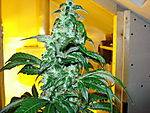hey guys in the next 4 weeks im going to have a go at making some s1 psychosis seeds and psychosis crosses . ill post updates as they happen . wish me luck lol .
a beautiful cross i reckon would be purple kush x psychosis.
both flavours are really intense, combined that would be something special. also boost the purple kush yield i reckon.
hint hint...






